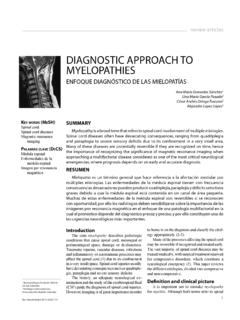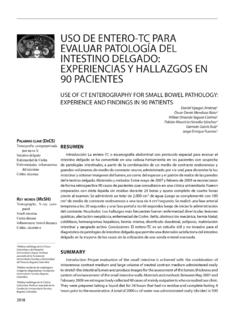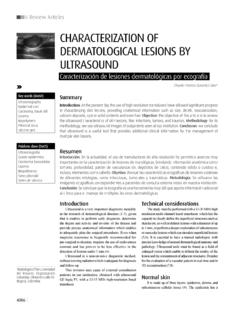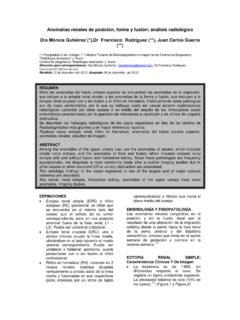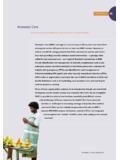Transcription of Soft- tissue foreign bodies: Diagnosis and removal …
1 soft - tissue foreign bodies : Diagnosis and removal under ultrasound guidance Gustavo Figueredo Casadei MD,Karina Romero MD, and Victor gomez MD Department of Radiology, CooperativaM dica de Rocha. Montevideo. Uruguay. ABSTRACT soft tissue foreign bodies due to penetrating injuries are a common reason for emergency department visits. We present a series of six cases in which ultrasound was used successfully not only as a diagnostic tool but also as a real-time guidance for their removal . Key words: ultrasound, sonography, foreign body, penetrating wounds. Contact- e-mail: OBJECTIVES This paper aims to fulfill two objectives; firstly to demonstrate the utility of diagnostic ultrasound in the detection and characterization of foreign bodies (FB) retained in soft tissues, and secondly to demonstrate the usefulness of ultrasound in their removal , allowing realtimecontrol maneuver. It also highlights the fact that ultrasound is the imaging method of choice when retained FB are clinically suspected.
2 INTRODUCTION FB retained in soft tissue are a common cause of consultation in adults and children (1,2,3,4), usually due to vegetal material (thorns) and lesser to metal and glass fragments. A FB undetected, can be a source of complications and malpractice lawsuits (5) Traditionally, and as the first imaging modality for the initial workup,radiography of the area is done, which primarily shows radiopaque objects. For several years ultrasound has been positioned as the first diagnostic method to visualize all types of FB, providing removal guidance. This article shows a series of patients with soft tissues FB in extremities, in which ultrasound was successful both in detection and removal . soft - tissue foreign bodies : Diagnosis and removal under ultrasound guidance P gina 2 MATERIALS AND METHODS The sample included 6 patients, studied between March and September 2011. The age ranges between 5 and 65 years, being 4 male and 2 female.
3 Patients were referred by surgeons for suspected FB from penetrating wounds, in all cases with an evolution of more than 10 days and less than two months. In five cases the agent, of organic origin was suspected (plant thorn) while it was unknown on a foot injury case. The symptoms in all cases were persistent pain in the affected area, even after the disappearance of the puncture wound. In a patient with a forearm injury, there was also significant edema and soft tissue infection, and signs suggestive of deficient ulnar nerve involvement. In three cases the wounds were located in the upper limbs, and the remaining in feet. In one case there had been previous conventional surgery without FB localization. Four cases underwent radiograph of the area, being negative. The other two cases were studied only with ultrasound. Ultrasonographic studies were performed using high frecuency (8-12 MHz) linear transducers in two units (General Electric and Esaotemodel My Lab 50).
4 RESULTS Case 1- 66 -year -old patient with a 15 day history of penetrating injury in foot plant, while swimming in a river. The patient does not know the nature of the traumatic agent. Retained FB is suspected. An X Ray is performed, which shows no abnormality. Given the persistence of pain, ultrasound is performed confirming a 32mm long FB. Consulting plastic surgeon suggested removal under ultrasound guidance. The procedure was performed through the primary traumatic point of entry, obtaining vegetable thorn. Favorable evolution ,without complications. Figures Case 1 Case 2- 55 -year -old female, with a 15 day history of penetrating injury in her right forearm by palm event, radiograph was obtained showing no evidence of FB 24 hours later she begins with soft tissue edema of the affected area, and fever. Partial response to antibiotics. Consultation with plastic surgeon was done. The requesting ultrasound study showed negative results.
5 Afterwards she installs deficit signs of ulnar nerve, whereupon the surgeon requests new ultrasound, confirming the presence of FB. removal of the FB is performed under ultrasound-guided. Regresion of deficient ulnar afectation as well as the infection were atteined. Figures Case2 Case 3- 8- year- old girl with a 25 days history of penetrating wound in right or left foot. FB is suspected with clinical palpation and is operated 10 days after. Conventional surgery cannot find the FB, and given the persistence of symptoms (pain) an ultrasoundstudy is performed. Ultrasound confirms FB, 10mm long, without reverberation phenomena, probably vegetable FB. Given the age of the patient, general anesthesia is performed and FB is extracted with ultrasound guidance without complications. Figures Case 3 soft - tissue foreign bodies : Diagnosis and removal under ultrasound guidance P gina 4 Case 4- 5-year-old boy, with a 12 day history of penetrating injury in dorsum of foot.
6 As pain continued, ultrasound was performed confirming the presence of an 8mm FB at the clinical problem area. Due to the inconsistency between the transducer size and localization, which made not possible the removal with ultrasound guidance,she has an intervention under general anesthesia. It is not possible to extract the FB by ultrasound, so skin is marked on the location and removed with conventional surgery. Case 5- 48-year-old male who works at a sawmill. 15 days before the consultation suffered a puncture wound in the left palm hand (hypothenar) with a wood splinter. A radiograph was performed. It showed no abnormalities. Given the persistence of pain in emergency consultation, an ultrasound was performed confirming the presence of a FB. An ultrasound-guided procedure was performed. A wood splinter larger than 15mm was removed. He progressed favorably. Case 6- 51-year -old male.
7 While pruning a tree suffers a palm penetrating wound in his right hand, on the basis of the fifth finger. Radiographis obtained from the affected area showed no FB images. Ultrasonography was performed confirming FB. Ultrasound-guided procedure is carried on, with the removal of a 12 mm wood splinter. Progressed favorably. In 4 patients XRays were performed, they failed to show evidence of FB, even in a case of a bulky one. Figures Case 1 Ultrasonography was diagnostic in all cases. Clinical examination was unable to make the Diagnosis in all cases. In 5 patients the FB was successfully removed under ultrasound guidance by the sonographer itself, as discussed in case 4, given the inconsistency between the transducer and the affected area the removal was not possible, so the FB localization is marked on the skin and removed with conventional surgery. In all cases the vegetable thorn was obtained and visualized as linear or cuneiform echogenic structures surrounded by a hypoechoic rim with faint shadow cones.
8 The sizes varied between 8mm and 30mm. All patients recovered favorably with pain remission, even in the case of the patient with ulnar compromise (Case 2), in which the referred motor deficit remitted with the FB removal . DISCUSSION FB held in soft tissues from penetrating injuries are common causes of consultation in emergency services. They are also considered as the second leading cause of emergency medical lawsuits. A FB that has not been removed, can lead to both acute and chronic complications such as allergies, inflammation and infection.(1,2,3,6,7). If FB is close to tendons they may cause tenosynovitis, and in case of nerves neuropathies, as it occurred in one patient in this study. There may also be migration to joints causing arthropathies and embolic complications due to access to the venous system. (1) According to the evolutionof the injury, the condition may be classified in stages: 1) Acute: less than 3 days.
9 2) Intermediate: 3 to 10 days. 3) Chronic: more than 10 days. (5) The sonographic appearance of FB is related to the evolution time. In our series, all patients were in chronic stage. soft - tissue foreign bodies : Diagnosis and removal under ultrasound guidance P gina 6 The economic cost of FB extraction with sonography is significantly lower than that of small conventional surgery, even in the case of children requiring general anesthesia. There are very significant benefits in shortening the surgery act Moreover, an ultrasound guided failed removal does not exclude conventional surgery. At our institution, there is agreement with the surgeons that the sonographer tries at first instance and by himself the FB removal . A critique of this study may be the low number of patients in this series, although it should be noted that it is a rare condition, taken in a short period of time, with a sample taken from a single geographic region, and carried on by a single operator.
10 Another limitation is that all the FB diagnosed were vegetable origin, so experience with other materials is lacking in this study. CONCLUSIONS For suspected FB, the first imaging method to be performed must be sonography which allows Diagnosis , interventional procedure removal , with great advantages for the patient. APPENDIX Soft- tissue foreign bodies : Diagnosis and removal technique under ultrasound guidance. The FB can be divided in two groups according to their composition: a) Metallic b) Organic c) Inorganic The metallic consist of any material with high atomic number, therefore they have the ability to stop the photons, and can be easily visible in conventional radiology (1,2,5,6,7) The organic are referred to the organic material of vegetal origin, such as wood splinters, vegetable thorns, etc. The inorganic materials come from not living beings, such as broken glass, plastics, rubber, etc. A) Diagnosis When a retained FB is suspected , the first method is clinical examination which is positive only when the FB is in superficial tissues and can be palpable.

